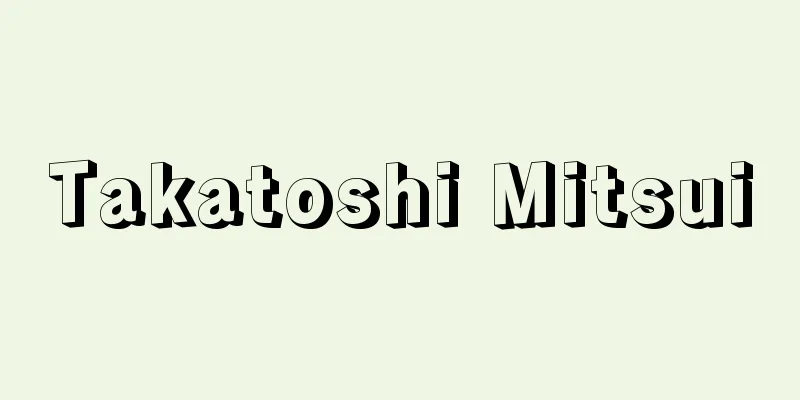Takatoshi Mitsui

|
Year of death: May 6, 1694 (May 29, 1694) Year of birth: Genna 8 (1622) A wealthy merchant in the early Edo period. Founder of the Mitsui family business. Commonly known as Hachirobei, his Buddhist name was Soju. His father was Mitsui Noribei Takatoshi (Buddhist name Dokyo) and his mother was Nagai-shime (Buddhist name Shuho) of Niwa (Taki-gun, Mie Prefecture), and he was the youngest of eight children. His grandfather had been a wealthy merchant family in Matsuzaka, Ise, and his ancestors were said to have been of samurai origin. His parents ran a sake shop and a pawn shop in Matsuzaka, and his mother, Juho, in particular, had excellent business acumen and was a wise wife who was frugal and hardworking, and the family business flourished smoothly. Takatoshi was strongly influenced by his mother, and in 1633, at the age of 12, he lost his father, but his eldest brother, Toshitsugu, already had a kimono shop in Honmachi 4-chome, Edo, and a purchasing store in Kyoto, and was doing business on a large scale, so in 1639, at his mother's command, he tacked 10 ryo worth of Matsuzaka cotton to his horse and went to Edo for the first time to learn business at his eldest brother's Edo store. Takatoshi was quick to spot a business opportunity and had excellent business acumen, and he gained the trust of his eldest brother and came to take control of the Edo store. However, Takatoshi also had the ideal of becoming a "Kyoto merchant with a store in Edo" in the future, and when he purchased land for a store in Edo Honmachi, his eldest brother feared that he would become a threat to his business in the future and began to estrange him, so in 1649 (Keian 2), he was sent back to Matsusaka under the pretext of supporting his mother. Takatoshi was 28 years old at the time. In Matsusaka, Takatoshi ran his own financial business (loan to feudal lords, loan to households, and village currency) and tried to increase his own funds. During this time, he married Nakagawa's daughter Kane (Jusan) and had 10 sons and 5 daughters, and he aspired to become a "Kyoto merchant with a store in Edo" while his children grew up. In 1667, when his eldest son Takahira turned 15, he was sent to his elder brother's Edo store as an apprentice, and the following year, when his son Takatomi turned 15, and in 1619, when his third son Takaharu turned 16, he was also sent to his elder brother's Edo store as an apprentice, while also making an effort to train storekeepers. In 1673, when his elder brother Toshitsugu passed away, the barrier to Takatoshi opening a store in Edo was removed, and he ordered his eldest son Takahira to rent a nine-foot-wide store in Honmachi, Edo, under the name "Echigoya Hachiroemon." He and Takahira rented an eight-foot-wide purchasing store in Yakushicho, Muromachi, Kyoto, and started a kimono business. Takatoshi was 52 years old at the time. Initially based in Matsusaka, he mobilized his children to actively run the kimono business, and eventually opened a money exchange store in Edo and another in Kyoto. Later, he moved his base from Matsusaka to Shinmachi Rokkakushita in Kyoto, and then opened a kimono shop and money exchange in Osaka. Thus, he developed his kimono and money exchange business in the three capitals of Kyoto, Edo, and Osaka, and gained a good reputation. Takatoshi prospered by attracting many customers, not only feudal lords and samurai, but also commoners, with his business methods of "low profit, high volume sales, no markup on silver (gold)" and "fixed price sales." He was also ordered by the shogunate to be the official supplier of kimono and gold and silver money (commonly known as contracting for public money money), and in one generation he accumulated a total of 81,250 ryo of koban (over 4,875 kan of silver). What is particularly noteworthy about Takatoshi was the extraordinary management of his store, which implemented one new innovation after another, such as lowering the prices of goods by purchasing directly from producers, a reward system for store clerks, investment and deposit of employees' wages, bargain sales, sale of kimono items by check, and an on-the-spot tailoring service. Furthermore, in 1694, as his illness worsened, he left a will entitled "Kakioki no Shidai" (A written document to be kept), in which, with a view to ensuring the continuity of the Mitsui family's business, he formed a strong family organization, devised a system of jointly managing business assets rather than dividing them, and distributing joint management and profits among family members in a set ratio, thus laying the foundation for the prosperity of the Mitsui family. Takatoshi's business philosophy became the guiding principle for Mitsui throughout the Edo period as the family business and store rules, and continues to have a strong influence today. His grave is at Shinnyodo Temple in Kyoto (Shinsho Gokurakuji Temple in Sakyo Ward, Kyoto City). <References> "Mitsui Takatoshi, the Founder of the Northern Family" ("Manuscript of Mitsui Family Materials") compiled by the Mitsui family, "Soju Daikoji Gyojyo" compiled by the same family, "Mitsui Takatoshi" compiled by Nakata Yasunao, "Mitsui Business History" main volume 1 compiled by Mitsui Bunko (Yasunao Nakata) Source: Asahi Japanese Historical Biography: Asahi Shimbun Publications Inc. About Asahi Japanese Historical Biography |
|
没年:元禄7.5.6(1694.5.29) 生年:元和8(1622) 江戸前期の豪商。三井家事業の創業者。通称八郎兵衛,法名宗寿。父三井則兵衛高俊(法名道鏡),母丹羽(三重県多気郡)の永井氏娘(法名殊法)の8人の子供の末子。祖父のころより伊勢松坂の裕福な商家で,その先祖は武士の出身という。両親は松坂で酒屋と質屋を兼営し,特に母珠法は商才に優れ,質素で勤勉な賢夫人で,家業も順調に盛んであった。高利はこの母の感化を強く受け,寛永10(1633)年12歳のとき父を失ったが,すでに長兄俊次が江戸本町4丁目に呉服店,京に仕入店を持ち,手広く商っていたので,同12年,母の命で小判10両分の松坂木綿を馬につけ,初めて江戸に出て,長兄の江戸店で商売を見習うことになった。高利は商機をみるに敏で商才に優れ,長兄の信頼を得て江戸店を支配するようになった。ところが高利も将来「江戸店持ち京商人」の理想を持っていて,江戸本町に店舗用の屋敷地を購入したことから,長兄は将来商売上の脅威になることを恐れ,高利を疎んずるようになり,慶安2(1649)年母を奉養する名目で松坂に帰されることとなった。高利28歳のときである。 松坂での高利は自ら金融業(大名貸,家中貸,郷貨)を行い,彼自身の資金の増殖をはかっていた。この間結婚して中川氏娘かね(寿讃)との間に10男5女をもうけ,この子供の成長を待って「江戸店持ち京商人」の理想を志していた。やがて寛文7(1667)年長男高平が15歳になると長兄の江戸店に見習に出し,次いで翌年次男高富15歳,さらに同12年3男高治16歳になると,同じく長兄の江戸店に見習に出す一方,番頭クラスの養成も心掛けていた。延宝1(1673)年長兄俊次が死去するにおよんで,高利の江戸出店の障壁が除かれることになり,長男高平に命じて江戸本町に間口9尺の店舗を借り,「越後屋八郎右衛門」の暖簾をかかげ,自らも高平と共に京都室町薬師町に間口8尺の仕入店を借りて呉服業を開始した。高利52歳のときである。 初め松坂に本拠を置き,子供達を動員して呉服事業を積極的に経営し,やがて江戸に両替店を併設,京都にも両替店を設けた。のち京都の新町六角下ルに松坂より本拠を移し,次いで大坂にも呉服店,両替店を設けた。かくして京都,江戸,大坂3都に呉服・両替業を展開,世評を博した。高利は「薄利多売現銀(金)掛値なし」「正札販売」の商法によって,大名,武士のみならず,多くの庶民の顧客を得て繁盛し,さらに幕府より公儀呉服御用達や金銀御為替御用達(一般に公金為替の請負という)を命じられ,一代にして総資産小判8万1250両(銀4875貫余)を蓄財した。 高利で特筆すべきことは,店の経営の非凡なことであって,生産者からの直買による商品の低価格化,店員の褒賞制,店員からの給金の運用預り,バーゲンセール,それに呉服物の小切販売,即座に仕立てるサービスなど新機軸を次々に実施している。また元禄7(1694)年病が重くなるや,「書置之次第」なる遺書を残し,三井家の事業の永続を考えて,強固な同族組織を形成し,事業資産を分割しないで共有とし,共同経営および利益を同族に一定の比率で配分する方式を考え出し,三井家隆盛の礎を築いた。高利の経営精神は家業・店則として江戸時代を通じて,三井の指導原理となり,今日にも強い影響を残している。墓地は京都・真如堂(京都市左京区の真正極楽寺)。<参考文献>三井家編「北家初代三井高利」(『稿本三井家史料』),同編『宗寿大居士行状』,中田易直『三井高利』,三井文庫編『三井事業史』本編1巻 (中田易直) 出典 朝日日本歴史人物事典:(株)朝日新聞出版朝日日本歴史人物事典について 情報 |
>>: Mitsuishi [town] - Mitsuishi
Recommend
Genbunichi - unified writing
It was one of the reform movements in the early M...
International Softball Federation
…The following year, in 1934, the United States S...
Bingo Kasuri
Cotton kasuri is produced in the area of Fukuya...
Gokase River
This river originates in the Kyushu Mountains in ...
Kamaboto - Kamaboto
...There are legends about the Kamadogami being a...
Chemotaxis - Chemotaxis
⇒ Chemotaxis Source: About Shogakukan Digital Daij...
Möller, JOL (English spelling) MollerJOL
...Scurvy, a disease caused by vitamin C deficien...
Megaloblastic anemia
…There are many causes of megaloblastic anemia, i...
Chaos Neural Network
...In combinatorial optimization problems, it is ...
Parliament of Alcala - Arukara Kaikai
...The university founded by Cisneros in 1508 (mo...
Anminsei
...Korean independence activist and politician. H...
Kannami [town] - Kannami
A town in Tagata County, eastern Shizuoka Prefectu...
aloesin
…The folk medicine Aloe vera was introduced to Ja...
agro-ecosystem
...To solve these problems, a new concept of pest...
Maratti, C.
…Italian painter. Also known as C. Maratti. Born ...









